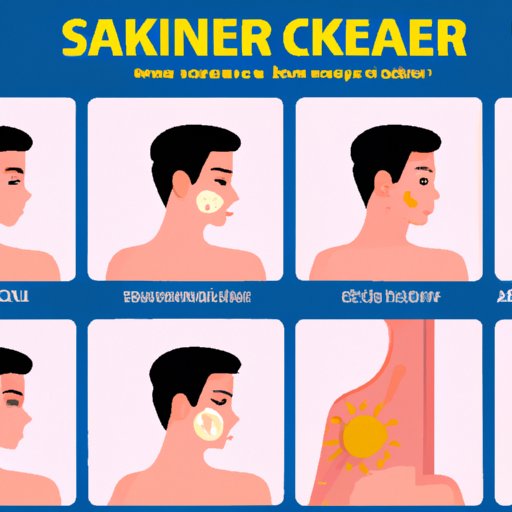
I. Introduction
Skin cancer is the abnormal growth of skin cells, which is often caused by too much exposure to ultraviolet (UV) radiation from the sun or tanning beds. According to the American Cancer Society, skin cancer is the most common type of cancer in the United States, with more than 5 million cases diagnosed each year. Early detection and prevention are crucial in reducing the risk of developing skin cancer, and in saving lives.
II. Symptoms of skin cancer to watch out for
Skin cancer can manifest in different ways, including changes in the size, shape, or color of moles or spots on the skin. Here are some of the most common symptoms of skin cancer to watch out for:
- Asymmetry: If one half of a mole or spot on your skin differs from the other half.
- Border: If the edges of a mole or spot are irregular, blurred, or notched.
- Color: If the color of a mole or spot is not uniform, and has shades of brown, black, red, white, or blue.
- Diameter: If a mole or spot on your skin is larger than a quarter inch in diameter.
- Evolving: If a mole or spot on your skin is changing in size, shape, or color; or if it starts to itch, bleed, or crust.
It’s important to note that not all changes in the skin are indicative of skin cancer, but any unusual changes should be evaluated by a medical professional.
III. Self-screening for skin cancer
You can perform a self-check on your skin at home to monitor any changes or new growths on your skin. Here’s a step-by-step guide for self-screening:
- Examine your face, including your nose, lips, and mouth.
- Check your scalp and neck, using a comb or mirror to separate your hair if needed.
- Examine the back, front, and sides of your arms, including your underarms.
- Check the palms of your hands, the spaces between your fingers, the backs of your hands, and your fingernails.
- Examine your chest and torso, including your breasts and nipples.
- Check your back and buttocks using a hand-held mirror or asking for assistance.
- Examine the backs of your legs, between your toes, your soles and the spaces between your toes.
- Check the tops of your feet and your toenails.
It’s essential to regularly check your skin, especially if you have many moles or freckles on your skin or have a history of skin cancer in your family.
IV. Understanding skin cancer risk factors
Several factors can increase your risk of developing skin cancer, including:
- Excessive sun exposure: Prolonged exposure to UV radiation from the sun can damage skin cells and increase the risk of skin cancer.
- Tanning beds: Tanning beds and sunlamps emit UV radiation, which can increase the risk of skin cancer.
- Fair skin: People with lighter skin have less melanin (pigment that protects the skin from UV radiation) and, therefore, are more susceptible to skin cancer.
- Family history: If a close relative has had skin cancer, you may have a higher risk of developing the disease as well.
- Age: As we age, our skin becomes thinner and loses its elasticity, making it more vulnerable to skin cancer.
You can reduce your risk of skin cancer by avoiding excessive sun exposure, using sunscreen regularly, and avoiding tanning beds. It’s also essential to wear protective clothing and seek shade when outdoors during peak hours of UV radiation.
V. The importance of regular skin check-ups
Regular skin check-ups by a dermatologist can detect skin cancer in its early stages, making it easier to treat and cure. The American Academy of Dermatology recommends scheduling a skin exam once a year if you have a history of skin cancer, and every two years for those without a history.
During a skin check-up, a dermatologist will examine your skin and evaluate any suspicious lesions or growths. They may also perform a biopsy (a sample of tissue removed for examination under a microscope) if they suspect skin cancer.
VI. Skin cancer prevention tips
Prevention is the best way to reduce the risk of developing skin cancer. Here are some tips to protect yourself:
- Wear protective clothing, including hats and sunglasses, when outdoors.
- Use a sunscreen with an SPF of at least 30, even on cloudy days.
- Avoid tanning beds and sunlamps.
- Seek shade during peak hours of UV radiation, typically between 10 a.m. and 4 p.m.
- Check the UV index before going outside.
VII. Sharing personal experiences with skin cancer
Personal stories of individuals who have been diagnosed with skin cancer can be an excellent way to raise awareness and encourage others to take action for their skin health. By sharing their journeys, they can provide valuable insight into the importance of early detection and prevention.
Some common themes among skin cancer survivors include the importance of protecting the skin from the sun and seeking regular check-ups with a dermatologist.
VIII. Conclusion
Early detection and prevention are crucial when it comes to skin cancer. Knowing the symptoms and performing self-screening can help you monitor any changes in your skin. Understanding risk factors and prevention tips can reduce your risk of developing skin cancer. Finally, regular check-ups by a dermatologist can detect skin cancer in its early stages. Remember, protecting your skin from harmful UV rays is key to maintaining optimal skin health.





